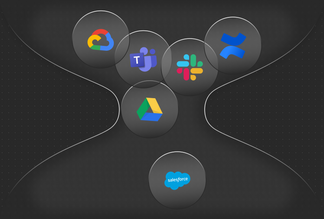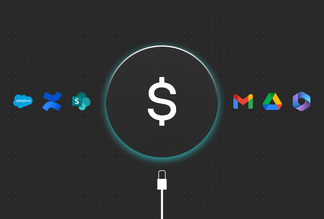

How big-picture thinking can inspire innovative teamwork
Our collaboration habits needed a revamp before the switch to remote work. Many of our tools actively contributed to negative working habits, allowing for an explosion of friction points for distributed workers. And goal-setting is one of those fundamental tasks that, without proper discoverability and contribution, can begin to break an organization from the top down.
We can’t keep looking through the rearview mirror. Goal-setting is an entirely new game when it has to align remote workers, and completely unique for hybrid teams. It’s up to us to connect purpose with innovative teamwork and transparency. That means getting everyone on board with the bigger picture.
How we think about the big picture at Qatalog
Sometimes, the big picture can feel like a moving target between teams. It’s the nature of start-up work to ebb and flow, that comes with the territory. And because we have a team that spans 24 languages and 14 nationalities, we had to find a way to keep everyone connected.
This is where our work hub comes into play. When it comes to big-picture thinking, teams need visibility in order to create momentum. Without it, progress remains stagnant and impossible to build upon.
Keeping 30 people involved with big-picture goals may seem like a lot of cooks in the kitchen, but the truth is that when everyone has a designated touchpoint that impacts the company, we all feel more engaged with our daily tasks. Plus, opening big-picture thinking to the whole team allows for new, innovative ideas.
Involve your team in the big picture
Big-picture thinking is the bird’s eye view of everything.
In a traditional office setting, many companies cover the big picture through face-to-face meetings such as weekly all-hands. Oftentimes, these meetings have to consist of big-picture thinking because of time constraints — summarizing details is extremely important to keep everyone invested.
With a distributed team, we move from physical space to digital space. Collaboration moves entirely to our tools in a combination of async and sync communication models. Considering these tools, we should be more connected than ever before with fewer communication barriers. Teams should be communicating exactly how their goals fit into the big picture across the organization in a discoverable format that improves upon the way we did things before.
In reality, we have a lot of things working against us: hyper-connectivity that leads to context switching, hard-shelled silos that seem impossible to break through, and a reliance on tools that often contribute to distraction.
Bring the big picture back into this environment, and it’s hard to provide visibility to disconnected employees. We need to take a look at the crutches we’ve leaned on that are hindering collaboration, and analyze how to bring our distributed teams together to accomplish these common goals.
Make company goals transparent for the whole team
The first step to engage a distributed team in the big picture is to make company goals discoverable to every employee. Company goals are the north star. They inform all teams where they should direct their focus. And as a team lead or manager, it's essential to find tools to help effectively communicate those goals.
Creating company goals in a work hub aligns teams and gives everyone transparency into the "why" for their projects. Anyone can assign goals and track progress, so accountability is evident. And if there are questions, team members know exactly who they need to speak with for clarity.
Give employees space to push back on big-picture goals
The days of business leaders getting together behind closed doors to discuss strategy and quarterly goals are over. Modern work has brought with it the expectation of transparent, equitable decision-making. And since we know that diverse teams are more innovative, we can utilize this when we think about creating company goals.
Once you've started a conversation about big-picture goals, encourage your team to provide feedback. Allowing your team to share their concerns and ideas will make them feel more connected to the "why" and the purpose of the big-picture goals.
Communicate across teams
Disconnected teams wreak havoc on production and in turn produce more work to be done.
Unfortunately, siloes are an all too familiar issue when it comes to remote work. When teams have transparency within them as well as the teams around them, they can fill in the gaps and see how their work plays a part in achieving company goals.
Collaborate regularly
Prior to remote work, our collaboration practices didn’t have to solve many of these pain points. They were just a regular part of our working day, not a major talking point for fixing work’s problems. Today, we look at collaboration differently. Not only is it integral to a company’s success, but it’s also what holds teams together.
Collaboration is important for every step of setting and meeting goals. If your team is unaware of what you’re trying to accomplish, you can’t be held accountable for the work you’re doing. This works on every level of the company. If teams can’t collaborate on company goals, there’s no point to having them in the first place. Make sure your big-picture goals are discoverable and transparent with the entire organization to allow for the level of collaboration you need to succeed.
Develop OKRs
OKRs are a basic goal-setting framework. They identify the big-picture goal or objective and use key results to track and measure the goal's status.
Before writing OKRs, hold a brainstorming session to decide what problems or challenges you’re trying to solve. Then think about what objective you can create to solve that problem. Lastly, identify the steps or key results needed to accomplish your goal.
Many companies have organization-wide OKRs — such as what the company hopes to achieve in the quarter or year. Company OKRs are great for employees to see the company's overall health, but it's also helpful to have team-level OKRs. You can collaborate with your team on these OKRs to identify what your team needs to do to contribute to the company's big-picture goals. If you work with a small or midsize team, you can also create OKRs for each person. Giving someone a goal to work toward throughout a specific time helps keep your team motivated and productive.
Use tech to connect the team around big-picture goals
Tech is not an end-all, be-all solution for remote teams. We now know that a lot of our work practices were outdated, and reliance on tools doesn’t automatically fix the systematic changes that exist. At the same time, tools are necessary to optimize your remote team. Collaboration will be slowed down without them.
This is why work hubs work. A work hub brings all the functionalities of your existing tools together under one roof, minimizing the pain point of adding just one more tool while connecting your team, wherever they are. Once you set up your work hub, you can find anything you're looking for with a quick search. You can also set OKRs, assign projects, connect with team members, and organize documents from one place.


